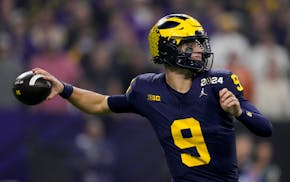On a warm summer night in Minneapolis, Marcus Jones jogged out of the Gophers' locker room at TCF Bank Stadium, having heard his coach plead for a big play.
Jones took his position near the goal line for the second-half kickoff, then darted for a 98-yard touchdown that gave the Gophers their first comfortable lead in what would become a 51-23 rout.
With one burst of speed, Jones offered a glimpse of all that is good in college football. The stadium noise swelling as a kid who goes to classes down the street bursts into the clear. The power of an individual's will. The unveiling of unappreciated talent. And the kind of moment that lingers in the memory.
"That's hard work, right there, manifesting itself,'' Jones said.
Jones gets it, all of it. He acknowledges that he may not be one of the best cornerbacks on the roster. He knows that suffering two knee injuries — one ACL tear in each, one during his freshman season, one last year as a sophomore — could have ruined a career he cherishes.
He knows that when he catches a kickoff, he has a few seconds to make all the rehab hours worth the effort, his chance to reward the coaches who recruited him despite his small frame out of Wake Forest, N.C.
He didn't need Adrian Peterson's miraculous recovery to inspire him. He didn't need anybody else to inspire him.
"Honestly, I didn't think about any other people during rehab,'' he said. "I just thought about wanting to play the game again. I love the game so much. After the first surgery, it was tough. After the second, I knew it would really be a test, trying to get back out there, because a lot of athletes don't make it through a second knee surgery.
"I just wanted to play again, with my team.''
The question is, why? Why put yourself through two rehabs in two years to return to the game that threatens to concuss or maim anyone who plays it, much less a guy listed at 5-8 and 166 pounds?
"Why?'' he asked. "Whooo. I don't know. There's so much about it that I love. I even love the summer workouts. I love everything about the game.
"A lot of it is the camaraderie between teammates. A lot of it is that you get to use that aggression, that speed. Everything that is a positive for you, you get to use to your advantage.
"I couldn't play basketball. I was too small. I tried baseball for a while and had a couple of injuries there. Football has meant a lot to me. You get a scholarship to play and a lot of your life turns into football at that point, because you're so grateful, because a lot of people do not get this opportunity.
"Football means so much because, the way I see it, if it wasn't for college football, I wouldn't get an education.''
Gophers coach Jerry Kill recruited Jones as a cornerback, then switched him to receiver out of necessity, and now has switched him back to cornerback.
In the fourth quarter, a UNLV back broke free for what looked like would be 75-yard touchdown run. Jones fought off a block, turned and ran him down, catching him with a diving tackle on the 11.
As a freshman, Jones returned a kickoff 92 yards for a touchdown against Purdue, and had another touchdown return, against Michigan, negated by a penalty.
Someone asked Jones if he had gotten all of his speed back.
"I don't know,'' he said. "Does it look like I have?''
Jones hadn't heard about one of those strange coincidences that sport so often concocts. Viking and former Gopher Marcus Sherels had — over at the Metrodome — also returned the second-half kickoff for a touchdown.
That's right: Two overachieving, undersized cornerbacks named Marcus who played at the University of Minnesota had returned second-half kickoffs for touchdowns a couple of miles apart on the same night.
"Really?'' Jones said. "Sounds like it was a good night for Minnesota.''
Jim Souhan can be heard weekdays at noon and Sundays from 10 to noon on 1500 ESPN. His Twitter name is @SouhanStrib. • jsouhan@startribune.com

Souhan: Now that's a playoff atmosphere, Minnesota!

Souhan: Should Vikings even consider McCarthy in NFL draft?

Souhan: NAW erases Suns' lead, Game 1 advantage with big performance

Souhan: This is KAT's chance to prove Flip Saunders was right

